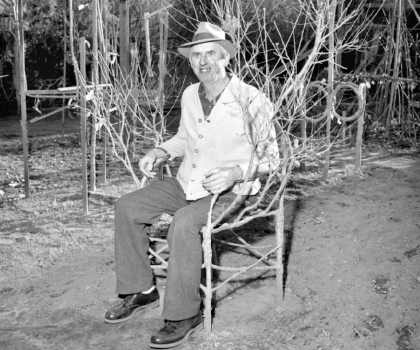
For over 40 years Erlandson felt divinely inspired to shape and graft the bodies and arms of trees. He passed away in 1964 but some of his arbor creations – dubbed Circus Trees – are still thriving and giving joy to visitors at Gilroy Gardens.
About 25 of his creations – because of him the term “arbor sculptor” was coined – are in the park near Watsonville, with a concentration located in the Dixie Cup Plaza near the turnstile area at the front entrance of the park as well as a scattering throughout.
Axel’s love of shaping trees occurred as a teenager when his family moved from Minnesota to Hilmar in Merced County. For a time he wanted to be a land surveyor but in 1928, after seeing a natural graft between two trees, he decided to merge four sycamore saplings into what he called the “Four-Legged Giant” spreading into a six-foot-around square cupola.

Inspired by a 1945 trip to Santa Cruz, Axel’s wife Leona suggested that he transplant his creations in Scotts Valley as a tourist spot. The Erlandsons invested $1,050 for three quarters of an acre along Highway 17 and as the 12 trees went dormant that winter, he dug them up to transplant them over 100 miles away. The effort took over three months and four loads of trees. He named his roadside attraction “Tree Circus” which billed the “World’s Strangest Trees.” Axel added a castle-like building for a souvenir shop and ticket office at the entrance. The attraction drew the attention of newspapers and Life magazine. Ripley’s “Believe It or Not” also took notice, featuring his trees in periodicals during the 1940s and 1950s. By 1957 Erlandson’s obsession resulted in 75 unique trees.
Between 1947 and 1963 about 20,000 people came to visit but charging 25 cents per head didn’t pay the bills. The death knell for the attraction was when Highway 17 shifted behind the center to its current route, cutting off the park from the motoring public. Poor health caused him to sell his enterprise in 1963 to Larry and Margaret Thompson for $12,000. After Axel’s passing in 1964 the Thompsons repurposed the tree park into a dinosaur themed “Lost World” attraction. At one time Disney was interested in the trees but lost interest because the asking price was too steep.
By the mid-1970s the collection of 40 remaining trees fell into a state of neglect until Santa Cruz architect Mark Primack led a group nicknamed the Commando Gardeners to trespass on the site to water and care for the trees. When word came that the owner wanted to bulldoze the trees, Primack recoiled and led a hotly-contested community battle to save them. The Scotts Valley Planning Commission rejected his bid to have them preserved as “heritage” trees and thus a relocation effort commenced. Nob Hill grocery store chain owner Michael Bonfante arranged to transplant 29 of the remaining coiled, scalloped and spiral-shaped sycamores, Box Elders, ash and Spanish cork trees in his Gilroy Gardens park in 1985.

The Telephone Booth Tree died years ago but remains permanently on display at the American Visionary Museum in Baltimore, Md.
If you’re heading to Gilroy Gardens and want to check out Erlandson’s work, be sure to pick up a Guide to the Circus Trees brochure from the Welcome Center, located in Sugar Plum Plaza.





